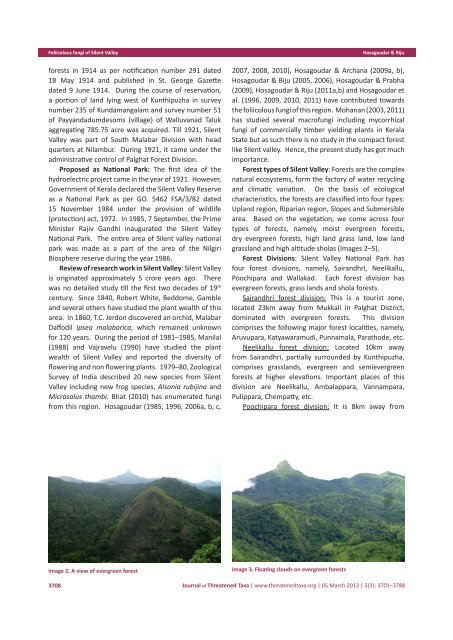PDF - Journal of Threatened Taxa
PDF - Journal of Threatened Taxa
PDF - Journal of Threatened Taxa
Create successful ePaper yourself
Turn your PDF publications into a flip-book with our unique Google optimized e-Paper software.
Foliicolous fungi <strong>of</strong> Silent Valleyforests in 1914 as per notification number 291 dated18 May 1914 and published in St. George Gazettedated 9 June 1914. During the course <strong>of</strong> reservation,a portion <strong>of</strong> land lying west <strong>of</strong> Kunthipuzha in surveynumber 235 <strong>of</strong> Kundamangalam and survey number 51<strong>of</strong> Payyandadumdesoms (village) <strong>of</strong> Walluvanad Talukaggregating 785.75 acre was acquired. Till 1921, SilentValley was part <strong>of</strong> South Malabar Division with headquarters at Nilambur. During 1921, it came under theadministrative control <strong>of</strong> Palghat Forest Division.Proposed as National Park: The first idea <strong>of</strong> thehydroelectric project came in the year <strong>of</strong> 1921. However,Government <strong>of</strong> Kerala declared the Silent Valley Reserveas a National Park as per GO. 5462 FSA/3/82 dated15 November 1984 under the provision <strong>of</strong> wildlife(protection) act, 1972. In 1985, 7 September, the PrimeMinister Rajiv Gandhi inaugurated the Silent ValleyNational Park. The entire area <strong>of</strong> Silent valley nationalpark was made as a part <strong>of</strong> the area <strong>of</strong> the NilgiriBiosphere reserve during the year 1986.Review <strong>of</strong> research work in Silent Valley: Silent Valleyis originated approximately 5 crore years ago. Therewas no detailed study till the first two decades <strong>of</strong> 19 thcentury. Since 1840, Robert White, Beddome, Gambleand several others have studied the plant wealth <strong>of</strong> thisarea. In 1860, T.C. Jerdon discovered an orchid, MalabarDaffodil Ipsea malabarica, which remained unknownfor 120 years. During the period <strong>of</strong> 1981–1985, Manilal(1988) and Vajravelu (1990) have studied the plantwealth <strong>of</strong> Silent Valley and reported the diversity <strong>of</strong>flowering and non flowering plants. 1979–80, ZoologicalSurvey <strong>of</strong> India described 20 new species from SilentValley including new frog species, Alsonia rubijina andMicrasalus thambi. Bhat (2010) has enumerated fungifrom this region. Hosagoudar (1985, 1996, 2006a, b, c,Hosagoudar & Riju2007, 2008, 2010), Hosagoudar & Archana (2009a, b),Hosagoudar & Biju (2005, 2006), Hosagoudar & Prabha(2009), Hosagoudar & Riju (2011a,b) and Hosagoudar etal. (1996, 2009, 2010, 2011) have contributed towardsthe foliicolous fungi <strong>of</strong> this region. Mohanan (2003, 2011)has studied several macr<strong>of</strong>ungi including mycorrhizalfungi <strong>of</strong> commercially timber yielding plants in KeralaState but as such there is no study in the compact forestlike Silent valley. Hence, the present study has got muchimportance.Forest types <strong>of</strong> Silent Valley: Forests are the complexnatural ecosystems, form the factory <strong>of</strong> water recyclingand climatic variation. On the basis <strong>of</strong> ecologicalcharacteristics, the forests are classified into four types:Upland region, Riparian region, Slopes and Submersiblearea. Based on the vegetation, we come across fourtypes <strong>of</strong> forests, namely, moist evergreen forests,dry evergreen forests, high land grass land, low landgrassland and high altitude sholas (Images 2–5).Forest Divisions: Silent Valley National Park hasfour forest divisions, namely, Sairandhri, Neelikallu,Poochipara and Wallakad. Each forest division hasevergreen forests, grass lands and shola forests.Sairandhri forest division: This is a tourist zone,located 23km away from Mukkali in Palghat District,dominated with evergreen forests. This divisioncomprises the following major forest localities, namely,Aruvupara, Katyawaramudi, Punnamala, Parathode, etc.Neelikallu forest division: Located 10km awayfrom Sairandhri, partially surrounded by Kunthipuzha,comprises grasslands, evergreen and semievergreenforests at higher elevations. Important places <strong>of</strong> thisdivision are Neelikallu, Ambalappara, Vannampara,Pulippara, Chempatty, etc.Poochipara forest division: It is 8km away fromImage 2. A view <strong>of</strong> evergreen forestImage 3. Floating clouds on evergreen forests3708<strong>Journal</strong> <strong>of</strong> <strong>Threatened</strong> <strong>Taxa</strong> | www.threatenedtaxa.org | 05 March 2013 | 5(3): 3701–3788

















